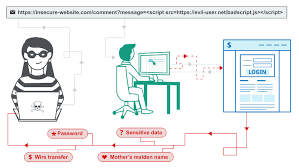How to Protect Your Website against an XSS Attack
XSS (cross-site scripting) attack is one of the most common methods used by cybercriminals to attack your website.
In this type of attack, a cybercriminal can take full advantage of an XSS vulnerability to stimulate a malicious JavaScript when anyone visits your website.
The cost of this type of attack can be very extreme, where the hacker can spread several malware on your website, and steal sensitive data and further use it for financial crimes or identity theft. A hacker can easily invite a user by hijacking their progressing session.
An XSS attack is not something that you will ever want to happen to your website, so in this article, we will talk about how to XSS a website and several other steps to protect your website from it.
But, it is also essential to understand how the XSS attack works.
How does an XSS attack work?
XSS is different from other hacking attacks, such as SQL Injection; by this, the attackers tend to hack the users of an application instead of the app itself.
A hacker will add a code, like malicious JavaScript, into the output of an online running application. Also, numerous places are vulnerable to these attacks, such as your cookies, your forums, and your search fields.

The main focus of the attacker is to collect the cookie data, as the cookies are mostly used to store confidential information like financial data, passwords, or usernames.
To give you an idea, a website contains a message board that allows the users to publish comments. All these comments are stored in an online database and are automatically displayed to other users without any encoding.
A hacker will easily submit a comment by adding a malicious script in it and enclose it by the <script> tags.
When another user comments, the script will be automatically executed and will gain the cookie information from the incoming visitor. Also, the script will run under the term of ‘secured website,’ that’s why your web browser will be unable to differentiate between content that is legit and content that is malicious.
There is one type of XSS attack, known as a persistent XSS attack, and is one of the most common attacks.
Another way of an XSS attack is by deceiving the user to click on an infected URL, which will add the code inside the page and give full access to the hacker to its content.
Now that you are familiar with the XSS attacks, we can talk about some useful steps that you can take to prevent such attacks from happening to your website.
Steps To Prevent an XSS Attack
Below are some strategies and steps that can help you to prevent an XSS attack and keep your website data safe.
Use an SDL
SDL is known as Security Development Lifecycle. You might have use SDL while developing your web application, and the main purpose is to limit the number of security flaws and coding errors in your application. By doing all this, it will make your website less vulnerable to these XSS attacks.
An SDL can automatically assume that all your web application data is coming and receiving from an untrusted source, even if the information is coming from the users that have signed in to your account several times.
For such reasons, SDL is beneficial to reduce these XSS vulnerabilities because we know that an XSS attack can still happen against those who have already signed in.
Adopt a crossing boundaries policy
A crossing boundaries policy states that all the authenticated users on your website have re-entered their login details to gain access to certain services and pages on your website.
Even if the user contains a cookie that enables them to log in automatically, you can still reset and make them enter their login details again before entering the pages.
This strategy is effective in preventing an XSS attack because it restricts the potential of a session that can be hijacked by an XSS attacker.
You can also expand this method so that the session will automatically expire when two different IP addresses try to utilize the same session data.
Use the right Meta tag
A meta tag can be used on each page on your website to declare the characters. The significant benefit of using a meta tag is that it will automatically decrease the number of potential forms that XSS script can take.
Conclusion
An XSS attack is one of the most common and harmful attacks that can happen to your website. In order to protect your website from such attacks, you can read the article carefully and know about each step in detail.
© 2025 Comodo Security Solutions, Inc





